09 May 2014
Overdose Fatalities On The Rise In New Jersey
 The National Safety Council (NSC) is a non-governmental, not-for-profit agency dedicated to promoting health and protecting life in the United States. The organization reports on and works to improve conditions in homes, at work and on the road. A recently published NSC report finds that drug and alcohol overdoses are the number one cause for accidental death in New Jersey – more than car accident fatalities.
The National Safety Council (NSC) is a non-governmental, not-for-profit agency dedicated to promoting health and protecting life in the United States. The organization reports on and works to improve conditions in homes, at work and on the road. A recently published NSC report finds that drug and alcohol overdoses are the number one cause for accidental death in New Jersey – more than car accident fatalities.
Like the rest of the nation, New Jersey recognized the wave of prescription drug abuse and responded strongly. State, along with federal officials, clamped down on access to prescription drugs. Making prescription drugs harder to get was seen as one way to reduce fatalities.
How Is The Problem Being Handled?
While efforts to place tighter controls has been effective to some extent, in another it may have only renamed the problem. Limited access has led to the street value of pills costing somewhere around $40 a piece, so many people simply switched to heroin, which is from the same family of drugs as prescription painkillers. It’s more powerful and less costly than it’s ever been, allowing drug abusers to switch to heroin when prescription pills are out of reach.
Substance abuse experts say that around 800,000 people in the Garden State have a drug or alcohol problem, yet just 10 percent ever ask for help. One clear way to bring down the number of accidental overdoses is to do a better job of convincing citizens to get help to break free of substance abuse.
The NSC says that the surge in overdose fatalities combined with the number of falls by senior citizens makes New Jersey homes the number one danger zone. New Jersey is not alone, however. Alcohol and drugs were reported as the leading cause of death in 20 states across the nation.
An opioid overdose is a situation that occurs when a person using an opioid drug or medication takes too much of the substance in question and experiences a serious slowdown or complete halt of certain critical body functions. Some people die from such an overdose, while others survive after receiving treatment. In a study scheduled for publication in April 2014 in the journal Mayo Clinic Proceedings, researchers from Harvard-affiliated Massachusetts General Hospital looked at the potential health outcomes for people who experience repeated opioid overdoses. These researchers also examined the factors that make repeated opioid overdoses more likely to occur.
What Are Opioids?
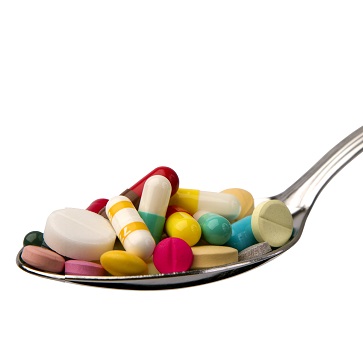 n addition to producing a pleasurable sensation called euphoria and diminishing the ability to feel physical pain, opioid drugs and medications slow down the baseline rate of activity inside both the brain and the spinal cord (known collectively as the central nervous system). If a legitimate opioid user or opioid abuser or addict keeps his or her intake within certain limits, he or she will experience only fairly modest changes in the function of these organs, which together produce and coordinate the nerve impulses required to keep the heart beating and the lungs inhaling and exhaling. However, if he or she takes too much of the opioid in question, central nervous system activity will fall below a critical point and the required nerve impulses will not be maintained. This dangerous and potentially lethal nerve signal disruption marks the onset of an opioid overdose. People who die from such an overdose typically experience an unsustainable decrease in their normal lung function.
n addition to producing a pleasurable sensation called euphoria and diminishing the ability to feel physical pain, opioid drugs and medications slow down the baseline rate of activity inside both the brain and the spinal cord (known collectively as the central nervous system). If a legitimate opioid user or opioid abuser or addict keeps his or her intake within certain limits, he or she will experience only fairly modest changes in the function of these organs, which together produce and coordinate the nerve impulses required to keep the heart beating and the lungs inhaling and exhaling. However, if he or she takes too much of the opioid in question, central nervous system activity will fall below a critical point and the required nerve impulses will not be maintained. This dangerous and potentially lethal nerve signal disruption marks the onset of an opioid overdose. People who die from such an overdose typically experience an unsustainable decrease in their normal lung function.
The United Nations Office on Drugs and Crime lists a number of common contributing factors to an opioid overdose. These factors include widespread access to both legal and illicit/illegal opioid substances, the use of opioids in combination with other mind-altering substances, limited access to treatment options for people addicted to opioid substances and an increased susceptibility to the effects of opioids in people who relapse back into drug/medication abuse after a period of full or partial abstinence. All individuals who abuse opioids run the risk of experiencing a fatal or non-fatal overdose, whether or not they have an addiction to opioid use.
Repeated Overdose Consequences
In the study scheduled for publication in Mayo Clinic Proceedings, the Massachusetts General Hospital researchers used information gathered from close to 20,000 adult opioid users to assess the health consequences of experiencing more than one non-fatal opioid overdose. All of these individuals had survived at least one overdose event involving a legal or illegal opioid; 1,400 of them had survived two to five such events. Although they represented only 7 percent of the study participants, the survivors of multiple events represented roughly 15 percent of the total number of overdoses among the participants. After comparing the single overdose survivors to the multiple overdose survivors, the researchers concluded that the multiple overdose survivors are significantly more likely to require hospitalization to deal with the effects of their condition. Once hospitalized, they are also significantly more likely to require breathing assistance from a ventilator to stay alive.
Repeated Overdose Factors
The researchers concluded that several factors contribute to the likelihood that a person will experience more than one opioid overdose. These factors include having relatively few financial resources, having public health insurance rather than private health insurance, having a diagnosable case of substance addiction, having a diagnosable mental illness, having an illness that affects normal nervous system function and having a chronic lung illness. The single demographic category most likely to experience multiple opioid overdoses is middle-aged white men.
The authors of the study scheduled for publication in Mayo Clinic Proceedings note that first-time cases of opioid overdose also frequently result in hospitalization. People undergoing additional overdoses merely have a higher chance of being hospitalized. First-time victims of opioid overdoses also sometimes require the use of a mechanical ventilator. Again, victims of multiple overdoses merely have greater odds of needing this extreme medical measure. The study’s authors believe that their findings point toward a need to improve local, state and nationwide efforts to lower the opioid overdose rate. They also point toward a need for improved understanding of the factors that contribute to overdose in people using prescribed opioid painkilling medications.
Read About IV Opioid Users Show Interest In Buprenorphine Treatment
05 May 2014
Prevent Prescription Drug Abuse In Your Teen
Prescription drug abuse is a major problem across the U.S. and for people of all age groups. Teens, however, are particularly vulnerable and if you have children you should be aware of the risks and dangers. There are two main kinds of drugs being abused by young people: narcotic painkillers and stimulants. The former are used to get a high, but the latter are often abused as a study aid. Stimulants, like those used to treat ADHD, produce wakefulness and many teens use them to stay up at night for studying.
The statistics regarding teen abuse of prescription drugs are alarming. Since 2008, abuse has risen by 33 percent. The statistics also show that most young people do not believe there are any risks in abusing prescriptions and that parents are largely ignorant when it comes to their children’s abuse of these drugs as well as the risks. Learn how to keep your teen safe.
Where Do Teens Get Prescription Drugs?
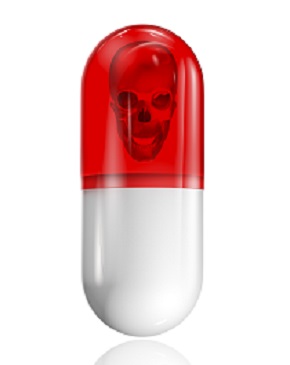 The first line of defense against abuse of prescriptions by your teen is to limit her access to them. So where are teens getting these medications? The most common location for teens to find prescriptions is the medicine cabinet. Teens get drugs right from their own homes. If they can’t find them there, they turn to their friends’ medicine cabinets. Many people are prescribed narcotics and stimulants, so finding them in homes is not difficult.
The first line of defense against abuse of prescriptions by your teen is to limit her access to them. So where are teens getting these medications? The most common location for teens to find prescriptions is the medicine cabinet. Teens get drugs right from their own homes. If they can’t find them there, they turn to their friends’ medicine cabinets. Many people are prescribed narcotics and stimulants, so finding them in homes is not difficult.
If the drugs cannot be pilfered, your teen can most likely buy them. Buying and selling prescriptions in high schools are common. Your teen may also be able to purchase medications online. Illegal pharmacies will not hesitate to sell to a teen.
How Can I Limit My Teen’s Access To Prescriptions?
With prescription medications so prevalent in homes, at schools and online, you need to be especially vigilant to restrict your teen’s access. If you have prescriptions in your home, keep them in a locked cabinet. If your teen has been prescribed one of these commonly abused medications, keep it locked up and dose it out to her as directed by her doctor. A common source for stolen medications is expired pills that have been forgotten or thrown in the trash. Be aware of your unused drugs, keep track of them and dispose of them properly.
Unfortunately, limiting your teen’s access to drugs at home is where your control ends. You cannot control her access at school or at friends’ houses. What you can do, though, is educate your teen about the risks and dangers of drug abuse. First read up for your own knowledge and then talk to your children about how harmful prescriptions can be. Although they are legal and prescribed by doctors, these factors do not mean they are safe for everyone.
It is also important to educate your family and friends about prescriptions and keeping them under control. Your teen may be able to find drugs at a grandparent’s house or any other family member’s, but if everyone kept tighter control of their medications, fewer drugs would end up on the black market.
Finally, it’s important that you maintain a close and open relationship with your teen. The more time you spend interacting and talking, the more able you will be to detect when something is wrong or if she is showing signs of abusing drugs. This healthy relationship will also mean that your teen will be more likely to come to you with questions, concerns, and problems related to drugs and drug abuse.
02 May 2014
Heroin Use In Kentucky Growing At Alarming Rates
Obtaining prescription drugs for non-medical purposes is often as simple as pilfering a medicine cabinet, but with national efforts aimed at curbing the misuse and abuse of prescription drugs there may be a changing trend in the popularity of prescription drugs versus street drugs. A report highlights the emerging increase in heroin use in Kentucky, and national trends mirror that data.
The report from the Kentucky Injury Prevention and Research Center (KIPRC) analyzes overdoses in Kentucky as well as associated mortality and financial consequences on the population. KIPRC is part of the University of Kentucky’s College of Public Health and is in partnership with the Kentucky Department for Public Health.36
The findings show that the number of total overdoses resulting in death or emergency room visits remained stable from 2011 to 2012. In addition, the number of overdoses due to benzodiazepines and prescription opioids decreased in that same period.
Why Are There So Many People Overdosing?
 The primary reason for overdose deaths in Kentucky was pharmaceutical opioids, and benzodiazepines were the primary drugs related to overdose ER visits, but they decreased nine percent, from a total of 939 visits in 2011 to 856 in 2012. The primary reason that admission was made for a stay in the hospital related to overdose was self-harm. The highest rates of overdose between 2008 and 2012 were found in Casey, Johnson, Carroll, Powell, and Nicholas Counties.
The primary reason for overdose deaths in Kentucky was pharmaceutical opioids, and benzodiazepines were the primary drugs related to overdose ER visits, but they decreased nine percent, from a total of 939 visits in 2011 to 856 in 2012. The primary reason that admission was made for a stay in the hospital related to overdose was self-harm. The highest rates of overdose between 2008 and 2012 were found in Casey, Johnson, Carroll, Powell, and Nicholas Counties.
The decrease in benzodiazepines and opioids may be explained by an increase in heroin use. There was a significant increase in inpatient hospitalization deaths and ER visits due to heroin use – 129 fatal overdoses in 2012, a 207 percent increase over the 42 deaths in 2011. There was also a 174 increase in hospitalizations and a 197 percent increase in ER visits related to heroin overdose.
The Substance Abuse and Mental Health Services Administration (SAMHSA) has also documented the increase in heroin use on a national scale. SAMHSA reports that heroin use grew by 80 percent from 2007 to 2012.
Likewise, the Centers for Disease Control and Prevention shows a 55 percent increase in overdose deaths related to heroin use for the period from 2000 to 2010. Many experts believe that the increase of heroin use and the decrease of prescription drug abuse are related.
The KIPRC report also provides an analysis of the costs that Kentucky incurs due to drug overdose. The total financial toll for the state rose by seven percent to $129.3 million in 2012, with $41.3 million billed to Medicare and $34.1 million to Medicaid.
Terry Bunn, PhD, director of KIPRC, says that the problem requires a comprehensive approach to finding strategies to alleviate the levels of drug abuse and the cost of treatment in Kentucky. The state needs to identify risk factors that lead to drug overdoses and develop interventions that prevent the likelihood of a drug overdose, she says. In addition, the report’s findings support the need for increased availability of naloxone, an opiate antidote that can be used by first responders as a lifesaving measure to prevent fatal overdose.
01 May 2014
Is Repairing Your Marriage After Rehab Possible?
Few things take a greater toll on relationships than addiction. If you are an addict in recovery and you are married, you may be wondering what will happen next. Is your spouse going to leave you? Will she ever trust you again? How will you ever make it up to her? Divorce in the aftermath of addiction is not uncommon, but it is possible to repair your marriage. You can make it up to your wife if you are both willing to do the work. The fact that you sought recovery is a sign that you can work toward repairing all aspects of your life damaged by addiction.
Is Divorce Inevitable After Addiction?
 Divorce may be common when one partner is addicted, but it does not need to be inevitable. Addiction is one of the biggest challenges your relationship will ever face, but you can bring it back from the brink. To do so, you both need to be on the same page. Have an honest and open discussion with your wife and find out if she is committed to working with you to repair your relationship. She may have doubts, but hopefully the fact that you were willing to ask for professional help will convince her that you are serious about making amends.
Divorce may be common when one partner is addicted, but it does not need to be inevitable. Addiction is one of the biggest challenges your relationship will ever face, but you can bring it back from the brink. To do so, you both need to be on the same page. Have an honest and open discussion with your wife and find out if she is committed to working with you to repair your relationship. She may have doubts, but hopefully the fact that you were willing to ask for professional help will convince her that you are serious about making amends.
How Do You Make Amends To Your Spouse?
Making amends is an important part of the recovery process and no one deserves it more than your partner. Addiction leads people to do hurtful things to the ones they love the most. You may have lied to her, cheated on her or neglected her. You have a lot of making up to do, and although it may seem daunting, it is possible.
Making up for all the hurt and damage does not mean that you have to spend the rest of your life groveling and giving in to your spouse. If that is what she is expecting, you are both headed down the wrong path. Making amends means apologizing and restoring her faith in you. To do so you need to treat her well, make heartfelt apologies and, most importantly, strive to avoid relapsing and sinking back into the hole of addiction.
Can Your Spouse Ever Trust You Again?
One of the biggest impediments to bringing back a healthy relationship is trust. What you damaged the most in your marriage was your wife’s trust. You probably promised over and over again to stop using, to stop lying, to stop cheating, and to be better. These were all promises you were incapable of keeping at the time, but they did damage to trust nonetheless.
The only way to develop trust is to earn it. Unfortunately, earning trust takes much more time than losing it. It takes many repeated instances of being reliable and dependable to earn trust. Make sure your wife understands that her trust will be slow to regain. Keep being the person she needs you to be, and with time, she will trust you again.
Repairing a marriage after the devastation caused by addiction is a difficult challenge, but not an impossible one. Be sure to communicate with each other about what you are feeling; rekindle your love for each other by spending quality time together and consider seeking the help of a professional marriage counselor. Perhaps most importantly, continue to work on your own recovery. The best way to show your spouse that you are committed to rebuilding your relationship is to stay sober and avoid relapse.
Find Out What Are The Ways To Recognize Addiction Denial In A Loved One?
Significant numbers of the people who commit crimes in America are affected by clinically diagnosable symptoms of substance abuse or substance addiction. Current evidence indicates that successful treatment of these individuals’ substance-related issues substantially reduces the chances that they will commit additional crimes in the future. According to results reported by the National Institute on Drug Abuse, successful treatment of criminal offenders with substance-related issues also carries a lower financial burden for society than the reincarceration of those individuals who continue their involvement in illegal activity.
Drug Abuse And Jail Time
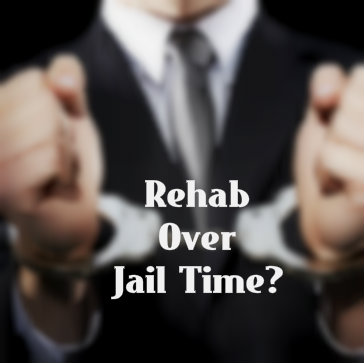 The close connection between substance problems and the chances of ending up in jail or prison is well documented. For example, figures compiled by the National Institute on Drug Abuse indicate that roughly 50 percent to 66 percent of the people incarcerated in a state jail or prison, or in a federal facility, have symptoms that could qualify them for an official diagnosis of alcohol use disorder (alcohol abuse or alcoholism). In addition, figures compiled for the year 2012 by the Substance Abuse and Mental Health Services Administration indicate that just over 25 percent of U.S. adults recently paroled from prison or under supervised prison release currently abuse either marijuana or some sort of prescription medication. Furthermore, well over a quarter (30.2 percent) of all U.S. adults who receive probation for criminal activity abuse marijuana or a prescription medication.
The close connection between substance problems and the chances of ending up in jail or prison is well documented. For example, figures compiled by the National Institute on Drug Abuse indicate that roughly 50 percent to 66 percent of the people incarcerated in a state jail or prison, or in a federal facility, have symptoms that could qualify them for an official diagnosis of alcohol use disorder (alcohol abuse or alcoholism). In addition, figures compiled for the year 2012 by the Substance Abuse and Mental Health Services Administration indicate that just over 25 percent of U.S. adults recently paroled from prison or under supervised prison release currently abuse either marijuana or some sort of prescription medication. Furthermore, well over a quarter (30.2 percent) of all U.S. adults who receive probation for criminal activity abuse marijuana or a prescription medication.
Medical Benefits Of Addiction Treatment
More than four out of five people in jail or prison with diagnosable substance problems don’t receive treatment for those problems while incarcerated. This means that the vast majority of affected individuals finish their sentences with their abuse or addiction issues intact. Statistically speaking, these individuals have an unusually high chance of committing more crimes, whether in direct support of their substance use or for other purposes. Current evidence strongly supports the usefulness of substance treatment for incarcerated men and women. Specific treatment approaches that produce positive results include both the use of substance-specific medications and the use of substance-specific counseling or behavioral therapy. Treatment settings that produce positive results include long-term residential communities called therapeutic communities (which work both inside and outside of a daily prison environment), the use of specialized courts that mandate both treatment participation and consequences for criminal activity, and the use of a specific form of case management called TASC (Treatment Accountability for Safer Communities).
Is Drug Treatment Cost-Effective?
The 2014 report from the National Institute on Drug Abuse details the results of a 2013 study published in the American Journal of Public Health by researchers from the University of California, Los Angeles. These researchers analyzed the financial impact of a California law, called the Substance Abuse and Crime Prevention Act of 2000, which mandated that people with little or no history of involvement with the criminal justice system receive parole for certain drug-related activities if they agreed to attend a suitable form of substance treatment.
The researchers gathered financial data from 42,000 active cases between the middle of 2001 and the middle of 2002 and compared that information with financial data from 47,000 active cases between the middle of 1997 and the middle of 1998. All of the people in the first group qualified for treatment under the Substance Abuse and Crime Prevention Act; all of the people in the second group would have qualified for treatment under that law had it existed at the time. After calculating all of the costs involved, the researchers concluded that treatment of offenders dealing with serious substance-related issues saved California an average of $2,300 per person. This equated to a total savings of roughly $100 million in a single year. Most of the savings came from reduced costs to the California prison system stemming from the need to house fewer individuals.
Despite the savings produced by treating first- and second-time offenders affected by substance issues, California stopped providing funding for enforcement of the Substance Abuse and Crime Prevention Act after 10 years. The authors of the study published in the American Journal of Public Health note that financial costs for dealing with the community-wide effects of substance-using criminal offenders are steadily trending upward. They also note the usefulness of programs such as the one employed in California throughout the first decade of the 2000s. This usefulness includes both economic savings and the achievement of substance treatment results for criminal offenders that match up well with the results gained by people not involved with the criminal justice system.
Millions of cigarette smokers across the U.S. are addicted to nicotine, a natural ingredient in tobacco capable of producing harmful, long-term changes in brain chemistry just like a range of other legal and illegal substances of abuse. In most cases, people who attempt to quit smoking do so without the help of an addiction specialist or any other health professional prepared to deal with nicotine addiction. In a study published in March 2014 in the journal Addiction, a team of British and Dutch researchers assessed the likelihood that smokers addicted to nicotine will successfully quit using cigarettes without professional help.
The Basics Of Nicotine Addiction
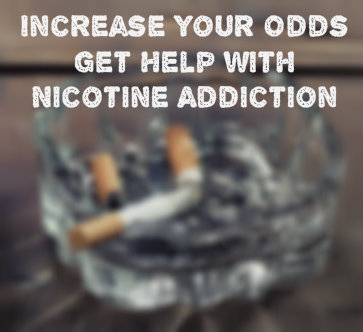 Nicotine addiction is related to a nicotine-induced chemical imbalance in the area of the brain responsible for producing pleasurable responses to various activities. This imbalance activates the pleasure center and gives a smoker an incentive to introduce nicotine into the brain again and again over time. This incentive is heightened by the fact that any single episode of nicotine exposure only briefly produces its pleasurable effects. Over 40 million American adults smoke cigarettes; since most habitual smokers are nicotine addicts, nicotine addiction constitutes the most widespread form of substance addiction in the U.S. More than two-thirds of the people who smoke cigarettes want to quit, according to figures compiled by the federal Centers for Disease Control and Prevention.
Nicotine addiction is related to a nicotine-induced chemical imbalance in the area of the brain responsible for producing pleasurable responses to various activities. This imbalance activates the pleasure center and gives a smoker an incentive to introduce nicotine into the brain again and again over time. This incentive is heightened by the fact that any single episode of nicotine exposure only briefly produces its pleasurable effects. Over 40 million American adults smoke cigarettes; since most habitual smokers are nicotine addicts, nicotine addiction constitutes the most widespread form of substance addiction in the U.S. More than two-thirds of the people who smoke cigarettes want to quit, according to figures compiled by the federal Centers for Disease Control and Prevention.
Smoking Cessation Techniques
The main smoking cessation technique available to a cigarette user who does not seek professional assistance is non-prescription nicotine replacement therapy. This approach relies on the use of over-the-counter nicotine-containing gum, lozenges or patches to gradually reduce an individual’s dependence on nicotine and help him or her avoid the unpleasant symptoms of nicotine withdrawal (which commonly act as a strong deterrent to smoking cessation efforts). Techniques used under the guidance of an addiction specialist or some other form of health professional include prescription nicotine replacement therapy (nasal sprays, inhalers or patches) and prescription nicotine-free medications such as varenicline (Chantix) or buproprion (Zyban), as well as forms of counseling that include short training and motivational sessions called brief interventions, longer group or individualized counseling sessions, remote counseling sessions that rely on phone or Internet technology and a form of in-person practical training called behavioral therapy. As a rule, a combination of professionally administered medication and counseling produces results that are superior to an all-medication or an all-counseling approach.
Chances Of Quitting Success
In the study published in Addiction, researchers from University College London and the Maastricht University Medical Centre used information gathered from a large-scale survey project called the Smoking Toolkit Study to compare the chances of smoking cessation success among people who make their own efforts to the chances of success among people who seek professional help. All told, data was collected from 10,335 smoking adults in England who had tried to stop using cigarettes one time or more in the year prior to the survey. The researchers broke these individuals down into four groups: people who received both professionally administered counseling and medication while trying to quit, people who only received professionally administered medication while trying to quit, people who tried to quit on their own with non-prescription nicotine replacement products and people who tried to quit on their own without using non-prescription nicotine replacement.
The researchers concluded that, compared to smokers who try to quit on their own without nicotine replacement products, smokers who try to quit while receiving professionally administered counseling and medication successfully stop smoking more than three times as often. Smokers who try to quit while only receiving prescription medication successfully stop smoking over 1.5 times more often than smokers who quit on their own without nicotine replacement products. Smokers who quit while only using non-prescription nicotine replacement successfully stop smoking about 0.96 times more often than those individuals who try to stop without any form of non-prescription medication or professional help.
The authors of the study published in Addiction note that, while there is some difference in the rates of smoking cessation success for people who only use over-the-counter nicotine replacement and people who use no assistance at all, the results in these two groups are close enough to qualify as “similar.” In contrast, people who receive a combination of counseling and prescription medication or just prescription medication clearly have improved odds of successfully quitting smoking.
Smoking cessation messages are public health advertisements and campaigns designed to encourage current smokers to stop using cigarettes, which contain the addictive substance nicotine. Some of these ads and campaigns focus on the steps required to quit smoking, while others focus on the reasons for quitting smoking. In a study published in March 2014 in the American Journal of Health Promotion, a team of American researchers compared the effectiveness of “how-you-can-quit” smoking cessation messages to the effectiveness of “why-you-should-quit” messages as motivations for actually attempting to cease cigarette intake.
Get The Anti-Smoking Message
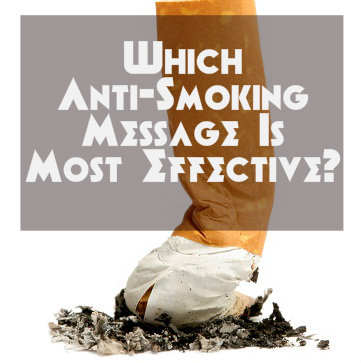 An agency inside the U.S. Department of Health and Human Services called the Substance Abuse and Mental Health Services Administration uses nationwide, annual survey information to track smoking rates among U.S. adults and teenagers. All told, about 22 percent of Americans in this broad age range smoke cigarettes each month. The peak smoking rate of 34.1 percent occurs among people between the ages of 21 and 25. People between the ages of 26 and 29 have a slightly lower smoking rate of 33.4 percent; in addition, close to a third (31.9 percent) of individuals between the ages of 30 and 34 smoke cigarettes. Three other segments of the population (people between the ages of 18 and 20, people between the ages of 35 and 39, and people between the ages of 45 and 49) also have a monthly smoking rate of over 25 percent. The monthly smoking rate drops below 20 percent only in adults age 60 or older and in children 17 and younger.
An agency inside the U.S. Department of Health and Human Services called the Substance Abuse and Mental Health Services Administration uses nationwide, annual survey information to track smoking rates among U.S. adults and teenagers. All told, about 22 percent of Americans in this broad age range smoke cigarettes each month. The peak smoking rate of 34.1 percent occurs among people between the ages of 21 and 25. People between the ages of 26 and 29 have a slightly lower smoking rate of 33.4 percent; in addition, close to a third (31.9 percent) of individuals between the ages of 30 and 34 smoke cigarettes. Three other segments of the population (people between the ages of 18 and 20, people between the ages of 35 and 39, and people between the ages of 45 and 49) also have a monthly smoking rate of over 25 percent. The monthly smoking rate drops below 20 percent only in adults age 60 or older and in children 17 and younger.
What Are Smoking Cessation Messages?
All smoking cessation messages have a target audience. In some cases, this audience is fairly broad and includes smokers from a range of backgrounds and segments of the population. In other cases, the target audience for a message is fairly narrow and includes only a single segment of the larger group of teen or adult smokers. In addition, some messages appear in isolation while others appear as part of larger, coordinated campaigns that continue for extended periods of time. Smoking cessation ads and campaigns can come from private institutions or from various levels of county, state or federal government. In addition, they can appear in a number of media settings, including TV, print or online outlets. Examples of recent campaigns undertaken on a national level include Tips from Former Smokers (from the Centers for Disease Control and Prevention) and Smokefree Teen (from the National Institutes of Health).
Which Anti-Smoking Messages Work?
In the study published in the American Journal of Health Promotion, researchers from an organization called RTI International used information gathered from 3,002 smokers age 18 or older to determine which smoking cessation messages have the greatest ability to foster quit attempts. The information-gathering sessions took place between late 2010 and early 2011; during these sessions, the study participants were exposed to two basic types of smoking cessation messages: those that focused on the ways in which smokers can halt cigarette use and those that focused on the real-world reasons for halting cigarette use. In turn, the “why-you-should-quit” messages were broken down into those that contained testimonials from other smokers and those that contained images demonstrating serious smoking-related health harms. Some participants viewed only one type of smoking cessation message, while others viewed various combinations of messages.
The researchers concluded that, compared to smokers who don’t view any smoking cessation messages, smokers who view only “why-you-should-quit” messages—or a combination of “why-you-should-quit” and “how-you-can-quit” messages—are significantly more likely to change their viewpoints on cigarette use and adopt a more pro-cessation outlook. They also concluded that, compared to smokers who don’t view any smoking cessation messages, most of the smokers who see “why-you-should-quit” messages are substantially more inclined to couple their change in smoking outlook with active attempts to halt their cigarette intake.
The authors of the study published in the American Journal of Health Promotion also concluded that, when viewed on their own, “how-you-can-quit” smoking cessation messages do not promote meaningful changes in smokers’ attitudes or an increase in smoking cessation attempts. Although they did not determine the long-term effects of exposure to “why-you-should-quit” messages, they believe that such messages may help promote ongoing cigarette abstinence. In addition, the study’s authors note that “how-you-can-quit” smoking cessation messages may not have their desired effect when used as a main technique for reaching smokers.
Read About How Stimulant And Smoking Addictions Can Be Treated Together


